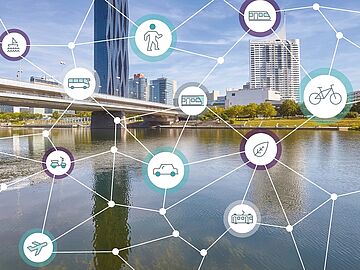The development of new shared mobility concepts and on-demand services such as car sharing, bike sharing, dynamic ridesharing and on-demand transit, includes a wide variety of new technology-enabled services and tools that give instant access to new integrated services of travel information and mobility solutions while complementing traditional modes like fixed-route transit. To make a good prediction of human reactions to new services and measures, it is key to understand the urban system as well as its interconnectedness and interactions with its environment. Based on these predictions, decision makers can improve the resilience of cities to natural disasters and climate change and prepare them for the necessary changes.
We develop methods which link urban and mobility strategies by providing novel planning tools on different scales (micro- to macroscopic and short- to long-term) enabling the investigation of impacts of urban space reorganizations and mobility measures (e.g. that can be used for urban planners and policy makers). A major concern in this respect is to design policies which strengthen a city‘s capacity to adapt to major developments like climate change, urbanization and major changes in the transportation system through automation or mobility as a service (MaaS), but also to shocks, such as natural disasters (e.g. flooding).
Since transportation is a crucial urban subsystem of a resilient city, robust methods for the prediction of mobility behavior, including rebound effects and demand prediction are of vital importance. We address this need by developing integrated approaches for modeling and simulation of (existing and emerging) mobility modes that can be used to evaluate city resilience outcomes under different scenarios. The results are used to develop policy measures that prepare cities and regions for climate change, societal and economic changes, and help the preparation of emergency, contingency, evacuation and recovery planning.
AIT’s research activities include:
- Analysis of mobility patterns in relation to the social milieus and identification of clusters in terms of behavioral and change processes
- Inclusion of human factors in the assessment of changes in the transport system for short term developments such as pricing structures, parking management, new public transport lines, sharing systems or road construction as well as mid and long-term additions like MaaS and automated vehicles
- Mobility demand modelling and supply management based on hard and soft measures
- Prediction of effects of new mobility concepts such as autonomous vehicles and Urban Air Mobility (UAM)
- Methods to identify and assess potentials for effective transport planning (e.g. cost-benefit analysis, rebound-/ backfire effects for reaching climate goals, balancing land use)
- Backcasting feasible paths towards aspired climate and mobility goals
- Simulating hazardous incidents and the impact of counter measures (e.g. risk analysis, investigation of scenarios, and recommendations for actions) for contingency plans






